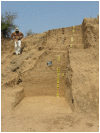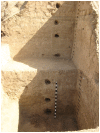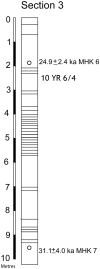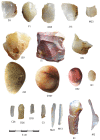Continuity of microblade technology in the Indian Subcontinent since 45 ka: implications for the dispersal of modern humans
- PMID: 23840912
- PMCID: PMC3698218
- DOI: 10.1371/journal.pone.0069280
Continuity of microblade technology in the Indian Subcontinent since 45 ka: implications for the dispersal of modern humans
Abstract
We extend the continuity of microblade technology in the Indian Subcontinent to 45 ka, on the basis of optical dating of microblade assemblages from the site of Mehtakheri, (22° 13' 44″ N Lat 76° 01' 36″ E Long) in Madhya Pradesh, India. Microblade technology in the Indian Subcontinent is continuously present from its first appearance until the Iron Age (~3 ka), making its association with modern humans undisputed. It has been suggested that microblade technology in the Indian Subcontinent was developed locally by modern humans after 35 ka. The dates reported here from Mehtakheri show this inference to be untenable and suggest alternatively that this technology arrived in the Indian Subcontinent with the earliest modern humans. It also shows that modern humans in Indian Subcontinent and SE Asia were associated with differing technologies and this calls into question the "southern dispersal" route of modern humans from Africa through India to SE Asia and then to Australia. We suggest that modern humans dispersed from Africa in two stages coinciding with the warmer interglacial conditions of MIS 5 and MIS 3. Competitive interactions between African modern humans and Indian archaics who shared an adaptation to tropical environments differed from that between modern humans and archaics like Neanderthals and Denisovans, who were adapted to temperate environments. Thus, while modern humans expanded into temperate regions during warmer climates, their expansion into tropical regions, like the Indian Subcontinent, in competition with similarly adapted populations, occurred during arid climates. Thus modern humans probably entered the Indian Subcontinent during the arid climate of MIS 4 coinciding with their disappearance from the Middle East and Northern Africa. The out of phase expansion of modern humans into tropical versus temperate regions has been one of the factors affecting the dispersal of modern humans from Africa during the period 200-40 ka.
Conflict of interest statement
Figures













Similar articles
-
Genetic and archaeological perspectives on the initial modern human colonization of southern Asia.Proc Natl Acad Sci U S A. 2013 Jun 25;110(26):10699-704. doi: 10.1073/pnas.1306043110. Epub 2013 Jun 10. Proc Natl Acad Sci U S A. 2013. PMID: 23754394 Free PMC article.
-
Early Middle Palaeolithic culture in India around 385-172 ka reframes Out of Africa models.Nature. 2018 Jan 31;554(7690):97-101. doi: 10.1038/nature25444. Nature. 2018. PMID: 29388951
-
Re-thinking the evolution of microblade technology in East Asia: Techno-functional understanding of the lithic assemblage from Shizitan 29 (Shanxi, China).PLoS One. 2019 Feb 25;14(2):e0212643. doi: 10.1371/journal.pone.0212643. eCollection 2019. PLoS One. 2019. PMID: 30802253 Free PMC article.
-
India at the cross-roads of human evolution.J Biosci. 2009 Nov;34(5):729. doi: 10.1007/s12038-009-0056-9. J Biosci. 2009. PMID: 20009268 Review.
-
The success of failed Homo sapiens dispersals out of Africa and into Asia.Nat Ecol Evol. 2018 Feb;2(2):212-219. doi: 10.1038/s41559-017-0436-8. Epub 2018 Jan 18. Nat Ecol Evol. 2018. PMID: 29348642 Review.
Cited by
-
Genetic and archaeological perspectives on the initial modern human colonization of southern Asia.Proc Natl Acad Sci U S A. 2013 Jun 25;110(26):10699-704. doi: 10.1073/pnas.1306043110. Epub 2013 Jun 10. Proc Natl Acad Sci U S A. 2013. PMID: 23754394 Free PMC article.
-
Microlithic variation and the Mesolithic occupations of western India.PLoS One. 2022 Jun 22;17(6):e0267654. doi: 10.1371/journal.pone.0267654. eCollection 2022. PLoS One. 2022. PMID: 35731740 Free PMC article.
-
Microliths in the South Asian rainforest ~45-4 ka: New insights from Fa-Hien Lena Cave, Sri Lanka.PLoS One. 2019 Oct 2;14(10):e0222606. doi: 10.1371/journal.pone.0222606. eCollection 2019. PLoS One. 2019. PMID: 31577796 Free PMC article.
-
A genetic chronology for the Indian Subcontinent points to heavily sex-biased dispersals.BMC Evol Biol. 2017 Mar 23;17(1):88. doi: 10.1186/s12862-017-0936-9. BMC Evol Biol. 2017. PMID: 28335724 Free PMC article.
-
Early to Mid-Holocene land use transitions in South Asia: A new archaeological synthesis of potential human impacts.PLoS One. 2025 Feb 12;20(2):e0313409. doi: 10.1371/journal.pone.0313409. eCollection 2025. PLoS One. 2025. PMID: 39937709 Free PMC article.
References
-
- White TD, Asfaw B, DeGusta D, Gilbert H, Richards GD et al. (2003) Pleistocene Homo sapiens from Middle Awash, Ethiopia. Nature 423: 742-747. doi:10.1038/nature01669. PubMed: 12802332. - DOI - PubMed
-
- Pinhasi R, Higham TFG, Golovanova LV, Doronichev VB 2011) Revised age of late Neanderthal occupation and the end of the Middle Paleolithic in the northern Caucasus. Proc Natl Acad Sci USA:108: 8611-8616. doi:10.1073/pnas.1018938108. PubMed: 21555570. - DOI - PMC - PubMed
-
- Brauer G (2007) Origin of modern humans. In: Henke W, Tattersall I. Handbook of Paleoanthropology. New York: Springer Verlag; pp. 1749-1779.
-
- Harvati K (2007) Neanderthals and their contemporaries. In: Henke W, Tattersall I. Handbook of Paleoanthropology. New York: Springer Verlag; pp. 1717-1748.
-
- Reich D, Green RE, Kircher M, Krause J, Patterson N et al. (2010) Genetic history of an archaic hominin group from Denisova Cave in Siberia. Nature 468: 1053-1060. doi:10.1038/nature09710. PubMed: 21179161. - DOI - PMC - PubMed
Publication types
MeSH terms
LinkOut - more resources
Full Text Sources
Other Literature Sources
Research Materials

